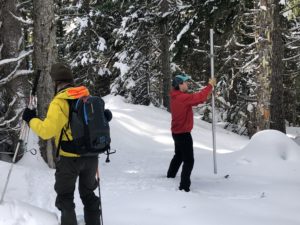
By Pepper Fisher
PORT ANGELES – Snowpack in the Olympic Mountains is better than normal so far this winter. More importantly, the outlook for March, traditionally the second snowiest month of the year, is certainly better than last year.
We did our annual check-in with Physical Scientist Bill Baccus, the man who heads up the snow surveys in Olympic National Park, to get a clearer picture of what irrigators here on the northern slope of the peninsula can expect this summer.
He reminded us that last winter started out pretty good, but a dry month of March ended up putting us slightly below normal in terms of snowpack.
“Where this year we’ve got kind of a colder snow pack. We have a deeper snow pack. And not only that, we have this prediction coming out of the Climate Prediction Center that we’re looking at least another month of La Nina conditions which are cooler and wetter than normal. And of course even just today, Pepper, we’ve had another about 12 inches of snow up at Hurricane Ridge. So that’s good. It’s been snowing pretty steadily.”
The USDA just put out its report on what they call the statewide water supply outlook, and they say the Olympics have about 130% of normal. Baccus says the term “normal” is misleading. As the guy who actually goes into the mountains every year and physically measures the depth of the snow, he calls the last 30 years of snowpack “the new normal”. Baccus says 130% of normal these days is what the old-timers might have called average or below.
“For those of us, like here in Port Angeles, it’s okay to think about our, kind of, new normal, because the normal is what we’ve had the last 30 years in the mountains. And really, for you and I, that’s our common experience. But the soapbox I always get on is talking about more of the long-term record. Just a good example would be a place like Deer Park, where folks around here used to ski in the 40s and 50s. This year at Deer Park, we’re 120% of the new normal. But if you looked at that for the entire 75-year period we’ve been collecting data, then that’s actually only about 80% of normal.”
Baccus says the evidence he gathers points to the wisdom behind the effort to build an off-channel reservoir next to the Dungeness River that would store water during the wet months and be released into the river in the dry months of summer.
“That’s absolutely true. You know, we are seeing that slow decrease in snowpack, and these warmer Springs and Summers. And so that is going to be very important.”

(Above: Measuring snowpack in the Olympic Mountains)
Photos by Bill Baccus.
